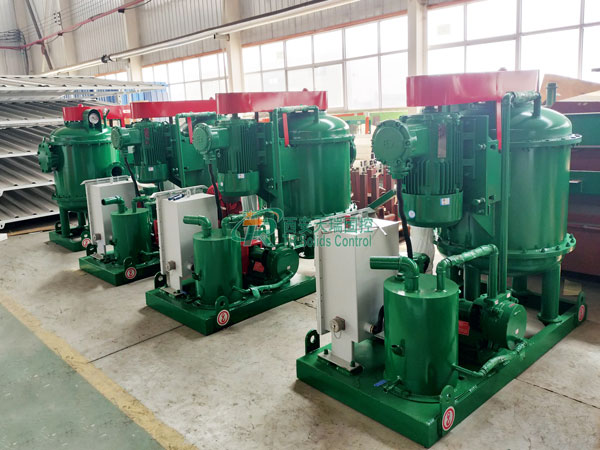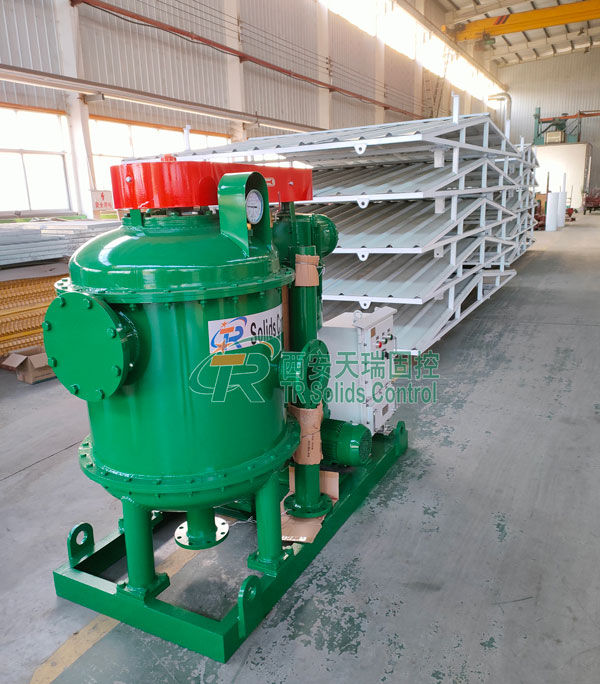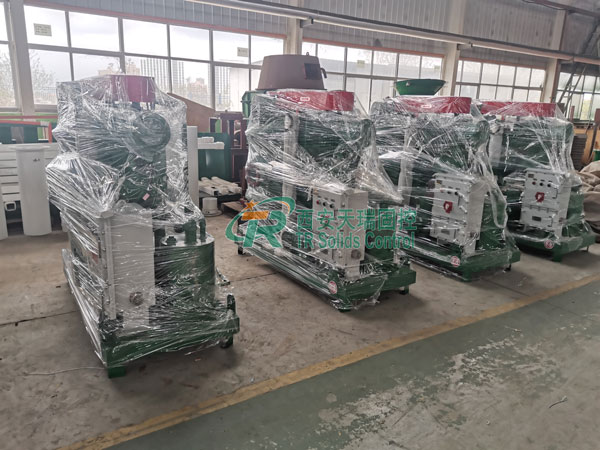In oilfield development, drilling fluid vacuum degassers are one of the core pieces of equipment for ensuring drilling safety and efficiency. Vacuum degassers create a negative pressure environment to forcibly separate gases (mainly natural gas and air) from the drilling fluid, maintaining the stability of the drilling fluid's performance and preventing safety accidents.
The negative pressure range of a vacuum degasser depends on the equipment model, vacuum pump type, and design parameters. Higher negative pressure results in more thorough gas removal from the liquid, but excessively high negative pressure can lead to abnormal slurry processing. Vacuum degassers optimize rotor structure, impeller speed, and vacuum adjustment range to ensure degassing efficiency exceeding 95%.
The negative pressure range of TR Solid Control's vacuum degasser (-0.030MPa to -0.065MPa) can meet the requirements of gas-liquid separation while avoiding abnormal mud treatment due to excessive negative pressure.

Tianrui drilling fluid vacuum degassers exhibit excellent efficiency, with its TRZCQ series products achieving degassing efficiencies of 95% to 99%. Specific technical design and operating parameters directly influence the effectiveness of the vacuum degasser.
Vacuum degree control
The TRZCQ series uses a water ring vacuum pump to create a negative pressure environment of -0.030 to -0.045 MPa within the vacuum tank. This negative pressure significantly reduces the solubility of gases in the drilling fluid, making it easier for tiny bubbles (less than 0.8 mm in diameter) to precipitate and separate. For example, when the vacuum reaches -0.04 MPa, dissolved and free gases in the drilling mud will rapidly expand and escape, achieving efficient degassing.
Processing capacity and power matching
The processing capacity varies from 240 m³/h (TRZCQ240) to 360 m³/h (TRZCQ360) depending on the model, with main motor power ranging from 15 to 37 kW and vacuum pump power from 2.2 to 7.5 kW. This design ensures a stable vacuum level even at high flow rates, preventing efficiency degradation due to excessive processing capacity. For example, the TRZCQ360 maintains a degassing efficiency of ≥95% at a flow rate of 360 m³/h.
mechanical separation structure
The slurry is sprayed onto the tank wall by the high-speed rotation of the rotor (860~880 r/min), forming a thin layer and breaking up air bubbles through collision. At the same time, the separation wheel further refines the gas-liquid mixture, enhancing the degassing effect. This physical separation mechanism, combined with vacuum suction, enables the equipment to operate effectively even under high gas content conditions.

Drilling in complex formations
In shale gas formations or carbonate rock formations containing high-pressure natural gas, the Tianrui degasser can quickly restore the mud density (typically increasing it by 0.05~0.1 g/cm³), preventing blowout risks and stabilizing mud performance. For example, after gas invasion, a shale gas well using TRZCQ270 reduced the mud gas content from 12% to below 0.5%, ensuring the safety of subsequent drilling.
Circulation system optimization
Deaerated mud can reduce the load on downstream solids control equipment (such as centrifuges) and extend their lifespan. For example, for every 1% increase in deaeration efficiency, the wear rate of centrifuges can be reduced by approximately 3%. Simultaneously, the equipment can also be used as a high-power mixer (15~37kW) to maintain mud homogeneity during non-aeration periods.
Environmental protection and cost control
Highly efficient degassing reduces emissions of harmful gases (such as H₂S), meeting environmental regulations. For example, in a certain oilfield, the use of the TRZCQ series reduced mud treatment costs by approximately 20%, primarily due to reduced reagent usage and extended equipment maintenance cycles.
The degassing efficiency of Tianrui's TRZCQ series (95%~99%) is significantly higher than that of traditional mechanical degassers (approximately 70%~85%). At the same throughput, the TRZCQ300's efficiency is 10 percentage points higher than competing products. In recent years, Tianrui Solid State Control has applied magnetic levitation technology to vacuum pump drives, developing a magnetic levitation vacuum degasser. This technology eliminates mechanical friction through non-contact magnetic levitation bearings, increasing vacuum pump efficiency by 12%~15%, while reducing noise to below 80dB and extending the maintenance cycle to 2 years.

Maintenance needs to be divided into "routine inspections" and "periodic maintenance," with a focus on vacuum levels, seals, and vulnerable parts.
Routine checks (once per shift)
Observe the vacuum gauge reading to ensure that the vacuum level is stable between 0.06-0.09 MPa (adjust according to the equipment model). If the vacuum level drops, check the vacuum pump seal and pipeline leaks.
Check the drilling fluid level to prevent overflow due to excessively high levels or "dry pumping" due to excessively low levels, which can damage the vacuum pump.
Check the operating sound of the motor and vacuum pump. If there are any abnormal noises, stop the machine and check whether the bearings or impeller are stuck.
Regular maintenance (weekly / monthly)
Change the vacuum pump lubricating oil weekly and clean the inlet filter to prevent impurities from clogging the pipeline.
Check the vacuum tank's sealing strips and valves for wear every month, and add grease to moving parts such as bearings.
Disassemble and inspect the vacuum pump impeller quarterly to remove scale and ensure pumping efficiency.
Troubleshooting
If "low degassing efficiency" occurs, first check whether the vacuum level meets the standard and whether the liquid inlet volume is uniform.
If "motor overload" occurs, check whether there are foreign objects blocking the impeller or whether the pipeline is blocked.

TR's solids control drilling fluid vacuum degasser stands out in the oil and gas drilling field due to its efficient separation technology, optimized parameter design, and reliable structure. Its 95%~99% degassing efficiency, high throughput, and low energy consumption make it a core piece of equipment in complex formation drilling and mud circulation systems. Users should pay attention to adjusting operating parameters and performing regular maintenance in practical applications to fully utilize the equipment's performance. They can also keep an eye on the development of new technologies such as magnetic levitation, providing a reference for future upgrades.
How efficient is TR's drilling fluid vacuum degasser?
Tianrui drilling fluid vacuum degassers exhibit excellent efficiency, with its TRZCQ series products achieving degassing efficiencies of 95% to 99%. Specific technical design and operating parameters directly influence the effectiveness of the vacuum degasser.

Address: No.2 Hu·ochang Rood, Yangling District, Xianyang City, Shaanxi Province, China
Tel: +86-13186019379
Wechat: 18509252400
Email: info@mudsolidscontrol.com
Contact: Mr.Li